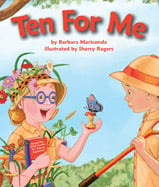Alignment to Standards for NM

| Grade | Number | Standard |
|---|---|---|
| 1 | SC-1)1.1.3.1. | Use numbers and mathematical language (e.g., –addition” instead of –add to,” –subtraction” instead of –take away”) to describe phenomena. |
| 1 | SC-1)2.2.1.1. | living organisms (e.g., plants, animals) have needs (e.g., water, air, food, sunlight). (and shelter) |
| 1 | SC-1)2.2.1.2. | living organisms inhabit various environments and have various external features to help them satisfy their needs (e.g., leaves, legs, claws). |
| 1 | SC-1)2.2.1.3. | differences and similarities among living organisms (e.g., plants, animals). |
| 1 | SC-1)2.2.1.4. | living organisms (e.g., plants, animals) have predictable but varied life cycles. |
| 1 | SC-1)2.2.2.2. | differences between mature and immature plants and animals (e.g., trees/seedlings, dogs/puppies, cats/kittens). |
| 1 | SC-1)2.2.3.1. | simple body functions (e.g., breathing, eating, sleeping) |
| 1 | SC-1)2.2.3.3. | some parts of human bodies differ from similar parts of other animals (hands and feet/paws; ears). |
| 2 | SC-2)2.2.1.1. | diversity exists among individuals within a population. |
| 2 | SC-2)2.2.2.1. | stages of the life cycle are different for different animals (e.g., mouse, cat, horse, butterfly, frog). |
| 3 | SC-3)2.2.1.1. | an adaptation in physical structure or behavior can improve an organismês chance for survival (e.g., horned toads, chameleons, cacti, mushrooms). |
| 3 | SC-3)2.2.1.2. | plants and animals have structures that serve different functions (e.g., shape of animalsê teeth). |
| 3 | SC-3)2.2.1.3. | Classify common animals according to their observable characteristics (e.g., body coverings, structure). |
| 3 | SC-3)2.2.1.4. | Classify plants according to their characteristics (e.g., tree leaves, flowers, seeds). |
| 4 | SC-4)2.2.1.1. | different living organisms have distinctive structures and body systems that serve specific functions (e.g., walking, flying, swimming). |
| 4 | SC-4)2.2.2.2. | a change in physical structure or behavior can improve an organismês chance of survival (e.g., a chameleon changes color, a turtle pulls its head into its shell, a plant grows toward the light). |
| 4 | SC-4)2.2.2.3. | living organisms have developed characteristics to improve chances of survival (e.g., spines on cacti, long beaks on hummingbirds, good eyesight on hawks). |
| K | SC-K)2.2.1.1. | major structures of common livings organisms (e.g., stems, leaves, and roots of plants; arms, wings, and legs of animals). |
| K | SC-K)2.2.1.2. | differences exist among individual living organisms (e.g., plants, animals) of the same kind. |
| K | SC-K)2.2.2.1. | similarities and differences in the appearance and behavior of living organisms (e.g., plants, animals). |
| K | SC-K)2.2.2.2. | living organisms (e.g., plants, animals) closely resemble their parents. |